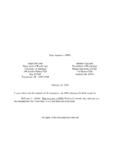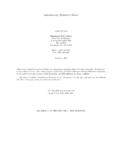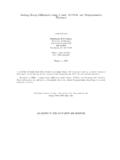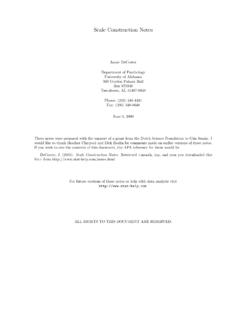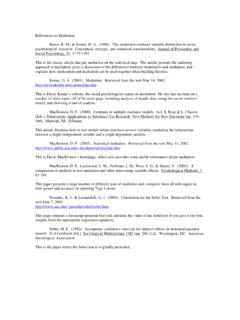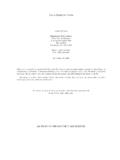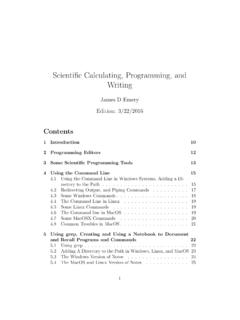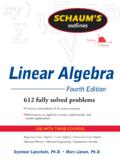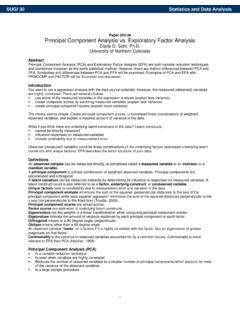Transcription of Overview of Factor Analysis - Stat-Help.com
1 Overview of Factor AnalysisJamie DeCosterDepartment of PsychologyUniversity of Alabama348 Gordon Palmer HallBox 870348 Tuscaloosa, AL 35487-0348 Phone: (205) 348-4431 Fax: (205) 348-8648 August 1, 1998If you wish to cite the contents of this document, the APA reference for them would beDeCoster, J. (1998). Overview of Factor <month, day, and year you downloadedthis file>from future versions of these notes or help with data Analysis RIGHTS TO THIS DOCUMENT ARE Theoretical Introduction12 Exploratory Factor Analysis23 Confirmatory Factor Analysis54 Combining Exploratory and Confirmatory Factor Analyses7iChapter 1 Theoretical Introduction Factor Analysis is a collection of methods used to examine how underlying constructs influence theresponses on a number of measured variables.
2 There are basically two types of Factor Analysis : exploratory and confirmatory. Exploratory Factor Analysis (EFA) attempts to discover the nature of the constructs influencinga set of responses. Confirmatory Factor Analysis (CFA) tests whether a specified set of constructs is influencing re-sponses in a predicted way. Both types of Factor analyses are based on theCommon Factor Model, illustrated in figure Thismodel proposes that each observed response (measure 1 through measure 5) is influenced partiallyby underlying common factors ( Factor 1 and Factor 2) and partially by underlying unique factors (E1through E5).
3 The strength of the link between each Factor and each measure varies, such that a givenfactor influences some measures more than others. This is the same basic model as is used for 1 Factor 2 Measure 1 Measure 2 Measure 3 Measure 4 Measure 5E1 E2 E3 E4 E5 >-ZZZZZ~JJJJJJJ^AAAAAAAAAAUZZZZZ~- > Figure : The Common Factor Model. Factor analyses are performed by examining the pattern of correlations (or covariances) between theobserved measures. Measures that are highly correlated (either positively or negatively) are likelyinfluenced by the same factors , while those that are relatively uncorrelated are likely influenced bydifferent 2 Exploratory Factor Objectives The primary objectives of an EFA are to number of common factors influencing a set of strength of the relationship between each Factor and each observed measure.
4 Some common uses of EFA are to Identify the nature of the constructs underlying responses in a specific content area. Determine what sets of items hang together in a questionnaire. Demonstrate the dimensionality of a measurement scale. Researchers often wish to develop scalesthat respond to a single characteristic. Determine what features are most important when classifying a group of items. Generate Factor scores representing values of the underlying constructs for use in other Performing EFAT here are seven basic steps to performing an need to measure your variables on the same (or matched) the correlation need to obtain the correlations (or covariances)
5 Between eachof your the number of factors for you have a specific hypothesis that willdetermine the number factors you will include, while other times you simply want your final modelto account for as much of the covariance in your data with as few factors as possible. If you havekmeasures, then you can at most extractkfactors. There are a number of methods to determine the optimal number of factors by examining your data. TheKaiser criterionstates that you should usea number of factors equal to the number of the eigenvalues of the correlation matrix that are greaterthan one.
6 The Scree test states that you should plot the eigenvalues of the correlation matrix indescending order, and then use a number of factors equal to the number of eigenvalues that occur priorto the last major drop in eigenvalue your initial set of must submit your correlations or covariances into a com-puter program to extract your factors . This step is too complex to reasonably be done by hand. Thereare a number of different extraction methods, including maximum likelihood, principal component,and principal axis extraction.
7 The best method is generally maximum likelihood extraction, unless youseriously lack multivariate normality in your your factors to a final any given set of correlations and number of factorsthere are actually an infinite number of ways that you can define your factors and still account for thesame amount of covariance in your measures. Some of these definitions, however, are easier to interprettheoretically than others. By rotating your factors you attempt to find a Factor solution that is equalto that obtained in the initial extraction but which has the simplest are many different types of rotation, but they all try make your factors each highly responsiveto a small subset of your items (as opposed to being moderately responsive to a broad set).
8 Thereare two major categories of rotations,orthogonal rotations, which produce uncorrelated factors , andoblique rotations, which produce correlated factors . The best orthogonal rotation is widely believedto be Varimax. Oblique rotations are less distinguishable, with the three most commonly used beingDirect Quartimin, Promax, and Harris-Kaiser your Factor of your measures will be linearly related to each of yourfactors. The strength of this relationship is contained in the respectivefactor loading, produced byyour rotation.
9 This loading can be interpreted as a standardized regression coefficient, regressing thefactor on the define a Factor by considering the possible theoretical constructs that could be responsible forthe observed pattern of positive and negative loadings. To ease interpretation you have the option ofmultiplying all of the loadings for a given Factor by -1. This essentially reverses the scale of the Factor ,allowing you, for example, to turn an unfriendliness Factor into a friendliness Factor scores for further you wish to perform additional analyses usingthe factors as variables you will need to construct Factor scores.
10 The score for a given Factor is alinear combination of all of the measures, weighted by the corresponding Factor loading. Sometimesfactor scores are idealized, assigning a value of 1 to strongly positive loadings, a value of -1 to stronglynegative loadings, and a value of 0 to intermediate loadings. These Factor scores can then be used inanalyses just like any other variable, although you should remember that they will be strongly collinearwith the measures used to generate Factor Analysis vs. Principal Component Analysis Exploratory Factor Analysis is often confused with principal component Analysis (PCA), a similarstatistical procedure.
